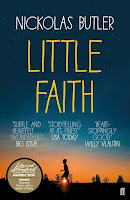 |
| (Amazon UK link) |
The novel, set in a small rural community in the United States, takes place over the course of a year, written in sections denoting the different seasons. Starting in Spring, we meet five-year-old, Isaac, playing hide-and-seek in a cemetery with his grandfather. Most of the story is told from the point of view of the grandfather, Lyle, who is happily married to Peg. They both feel quite elderly; I had assumed he was at least 75 in the early chapters, so was startled to discover that he’s only 65.
It’s clear to the reader early on that Isaac is likely diabetic; he drinks a vast amount, pees more than his grandfather, and his mother doesn’t like him to eat anything sweet, although for some reason she hasn’t mentioned his condition to his grandparents. And they, like grandparents everywhere, assume his mother Shiloh is being over-strict and give him ice cream or other treats when they’re looking after him.
Isaac and his mother are living with his grandparents at the start of the book, and we learn that they’re quite a close family although Shiloh wasn’t an easy teenager. Lyle and Peg are church-goers, fairly traditional in practice, although Lyle lost his faith many years earlier when their baby son died. We never learn what caused this. Shiloh is part of a newer, livelier church which, as becomes increasingly clear, is not just a charismatic congregation but cultish, believing that all illness has its root in sin, and that to see a doctor would be indicative of a lack of faith.
Apparently the story - and it’s a poignant one - was based on real events that took place in Wisconsin in 2008. It’s similar to incidents I’ve heard of before, where people refuse (or try to refuse) medical assistance even for serious health problems. Sad enough when it’s themselves, a tragedy when it involves a child.
There’s more to the story than this main thread. We see how Shiloh becomes sucked more and more into the cultish church, causing stress for Lyle and Peg, who want to protect their grandson without alienating their daughter. We also see Lyle’s best friend suffer a frightening diagnosis of a different illness. And there are sidelines about apple picking, and some evocative descriptions of the countryside, and the way of life in this small town which weren’t entirely relevant, but painted a broader picture of everyday life in this community.
I loved the writing and mostly liked the people too, although I couldn’t quite make an emotional connection to any of them. I found the book almost impossible to put down once I'd started. I was prepared to feel a bit defensive about faith and prayer, but felt that the author handled it very well. Lyle and Peg’s pastor is a good friend of theirs, and some interesting discussions result. He absolutely believes in the power of prayer, but alongside rather than instead of medical assistance.
My only disappointment was in the ending; it’s fairly obvious what’s happening with Isaac, although it’s not spelled out. But we don’t discover what happens to Lyle’s friend, or Lyle himself, or Shiloh…maybe that’s what the author intended, but I’d have liked an epilogue tidying up a few ends.
Other than that, I thought it an excellent novel, one that might help educate people about the symptoms of childhood diabetes, and also help them explore ways that prayer, faith and medicine can go alongside each other.
Recommended, if you don't mind a fair amount of description and an inconclusive ending.
Review copyright 2023 Sue's Book Reviews
No comments:
Post a Comment